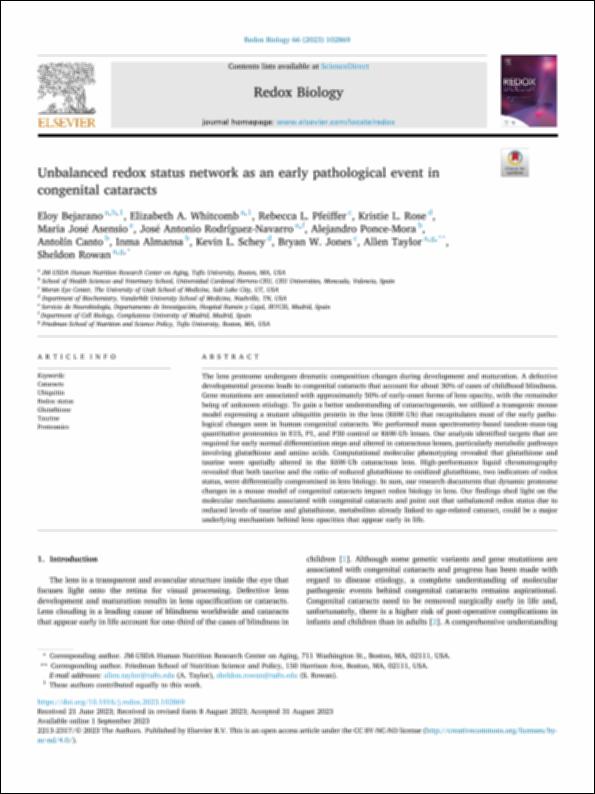Please use this identifier to cite or link to this item:
http://hdl.handle.net/10637/15195Unbalanced redox status network as an early pathological event in congenital cataracts
| Title: | Unbalanced redox status network as an early pathological event in congenital cataracts |
| Authors : | Bejarano Fernández, Eloy Whitcomb, Elizabeth A. Pfeiffer, Rebecca L. Rose, Kristie L. Asensio, María José Rodríguez Navarro, José Antonio Ponce Mora, Alejandro Cantó Catalá, Antolín Almansa Frías, María Inmaculada Schey, Kevin L. Jones, Bryan W. Taylor, Allen Rowan, Sheldon |
| Keywords: | Cataratas (Oftalmología); Cataract; Glutatión; Glutathione; Genética; Genetics; Oxidación biológica; Oxidation, Physiological; Envejecimiento; Aging; Proteínas; Proteins |
| Publisher: | Elsevier |
| Citation: | Bejarano, E., Whitcomb, E.A., Pfeiffer, R.L., Rose, K.L., Asensio, M.J., Rodríguez-Navarro, J.A., Ponce-Mora, A., Canto, A., Almansa, I., Schey, K.L., Jones, B.W., Taylor, A. & Rowan, S. (2023). Unbalanced redox status network as an early pathological event in congenital cataracts. Redox Biology, vol. 66, art. 102869 (oct.). DOI: https://doi.org/10.1016/j.redox.2023.102869 |
| Abstract: | The lens proteome undergoes dramatic composition changes during development and maturation. A defective developmental process leads to congenital cataracts that account for about 30% of cases of childhood blindness. Gene mutations are associated with approximately 50% of early-onset forms of lens opacity, with the remainder being of unknown etiology. To gain a better understanding of cataractogenesis, we utilized a transgenic mouse model expressing a mutant ubiquitin protein in the lens (K6W-Ub) that recapitulates most of the early pathological changes seen in human congenital cataracts. We performed mass spectrometry-based tandem-mass-tag quantitative proteomics in E15, P1, and P30 control or K6W-Ub lenses. Our analysis identified targets that are required for early normal differentiation steps and altered in cataractous lenses, particularly metabolic pathways involving glutathione and amino acids. Computational molecular phenotyping revealed that glutathione and taurine were spatially altered in the K6W-Ub cataractous lens. High-performance liquid chromatography revealed that both taurine and the ratio of reduced glutathione to oxidized glutathione, two indicators of redox status, were differentially compromised in lens biology. In sum, our research documents that dynamic proteome changes in a mouse model of congenital cataracts impact redox biology in lens. Our findings shed light on the molecular mechanisms associated with congenital cataracts and point out that unbalanced redox status due to reduced levels of taurine and glutathione, metabolites already linked to age-related cataract, could be a major underlying mechanism behind lens opacities that appear early in life. |
| URI: | http://hdl.handle.net/10637/15195 |
| Rights : | Open Access http://creativecommons.org/licenses/by-nc-nd/4.0/deed.es |
| ISSN: | 2213-2317 (Electrónico) |
| Issue Date: | Oct-2023 |
| Center : | Universidad Cardenal Herrera-CEU |
| Appears in Collections: | Dpto. Ciencias Biomédicas |
Items in DSpace are protected by copyright, with all rights reserved, unless otherwise indicated.


